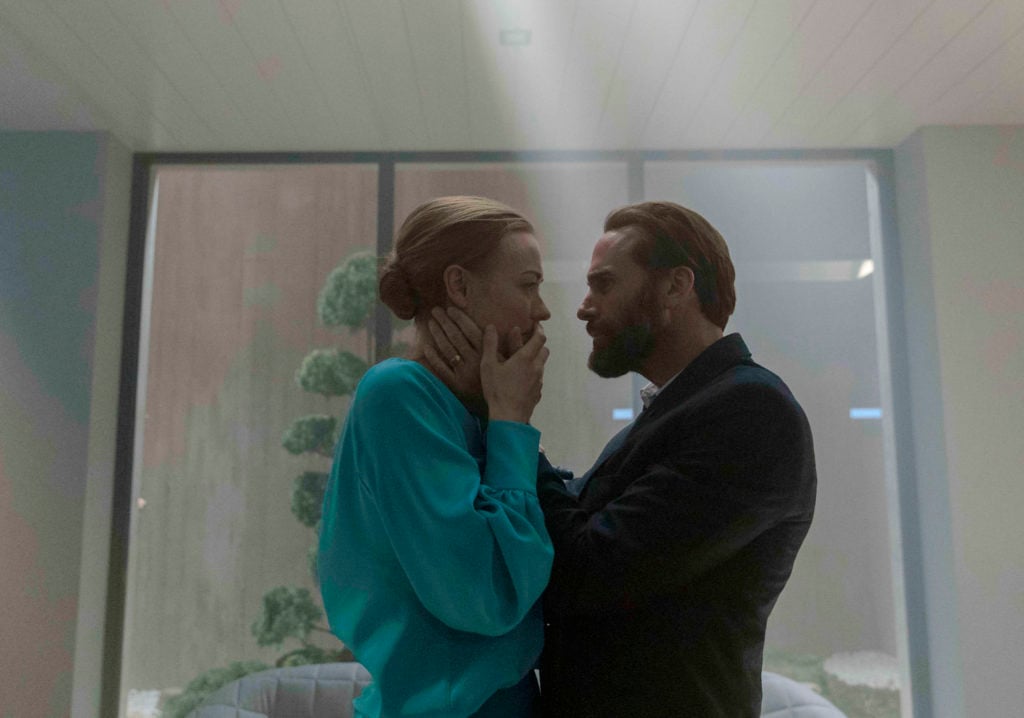“And the Lord said, I have seen my people in bondage, and I have heard their cry. I know their sorrows. And I am come to deliver them from the hand of evil men, and to lead my people out of that sorrowful place to a land flowing with milk and honey” (Exodus 3:7).
It’s definitely fitting that season 3 of the Hulu Original series The Handmaid’s Tale chose to end with our heroine June Osborne (Elisabeth Moss) reciting this Bible passage. This season, June became a handmaid Moses when she metaphorically saw her burning bush and realized her calling: to free the children of Gilead. This, combined with the surprise arrest of the Waterfords in Canada, made the last three episodes of season 3 some of the best of the entire series. However, up until that point, the season, much like Moses in the Bible, seemed to lose its way a bit in the middle.
(Spoiler Warning: What follows contains details about the third season of The Handmaid’s Tale including the season finale).
The Handmaid’s Tale is in a unique position: It’s an adapted work that has passed its source material. Margaret Atwood’s 1985 novel, for the most part, consists of what we saw in the first season. The season 1 finale ends where the book did, except for an epilogue that takes place after the fall of Gilead. If this situation sounds familiar, that’s because the same thing happened with another popular television drama you may have heard of: Game of Thrones. Both blockbuster shows were based on books but then ran out of written material to adapt. Many Game of Thrones fans were unhappy with the final season, blaming the writing and citing the lack of George R.R. Martin’s words to guide the ending to his story. But while the problem with both shows may be the same, the solutions taken by each are the opposite: for Game of Thrones, the writers went too fast and tried to cram too much into a limited number of hours they had left to tell the story. The Handmaid’s Tale, on the other hand, seems to be going too slowly, stretching out the story to fill the latest season.

(Jasper Savage/Hulu)
Perhaps June’s rescue mission could have happened mid-season rather than dragging out the Nichole story, or the Ofmatthew one for that matter. And as much as we all love Christopher Meloni, was his character Commander Winslow really even necessary? It’s clear that both Winslow and Ofmatthew’s murders contributed to June’s decision to help get the children out, but she probably could have gotten there a little more quickly without these two storylines dragging on over multiple episodes. It was really the storylines in Canada and involving June’s child-saving plan that made this season worth watching.
If we’re sticking to the Exodus metaphor, the season — and really the series so far — forced us to watch June and all the other women of Gilead getting beaten down as slaves every episode for a reason- so we can eventually get a pay off whenever the end comes. But three seasons before we even get to June’s burning bush moment is a lot to take in. It’s great that they finally started moving the story along toward the eventual defeat of Gilead, but three seasons at 13 episodes a piece to get there has left a lot viewers understandingly impatient.
The best example of how the writers stretched out the season lies with Serena Waterford’s character, played brilliantly by Yvonne Strahovski. Sure, at her core she longs for children and longs to reunite with Nichole, whom she truly loves. This is definitely a believable motivator for her character. She realized that Nichole staying in Canada was what was best for her (after all, they don’t cut off women’s fingers for reading there), but by mid-season, she 360’ed and tried to bring Nichole back to Gilead. It’s true that sometimes pure love can blind people and make them do selfish and stupid things, but somehow I never believed it for Serena.
In the end, it appeared as if Serena’s character got some vindication when she shockingly turned her husband into Canadian authorities in order to be with Nichole (thanks to some strategically planted seeds by June). It also appeared as if Serena was going to be mixing into Canadian society, placed into a world just like the one she helped bring down. But alas, the writers once again didn’t do justice to the character, turning her into a prisoner instead. We’ve already seen how Serena is when she’s trapped and not allowed to use her brain to its full extent. It would have been great for viewers to see what she was like outside of Gilead, and hopefully we will.

(Sophie Giraud/Hulu)
It’s important to mention, however, that there were two worthwhile midseason storylines. The first is that the audience finally got to see Aunt Lydia’s (Ann Dowd) backstory, and it didn’t disappoint. It’s a little crazy that we had to wait three whole seasons before we saw what this fascinating character was like before the dystopian downfall of America, but making her a teacher really helped flesh her out. Viewers got to see where her compassion for children came from, but more importantly, how some of her children were mistreated by their parents. Knowing this was her experience before Gilead really paints a fuller picture behind her behavior.
The second instance was a one-two punch in episode 6 when viewers got to see Washington, D.C. As if the images of the Washington Monument turned into a cross or Lincoln missing his head in his Memorial weren’t enough, we got to see the latest trend for handmaids in the capital: hoops lodged in their lips so they can’t speak. While the message of taking away these women’s voices couldn’t have been more clear, the image itself was shocking and really showed how things can escalate when the wrong people are in power.
It will be interesting to see where the show goes from here and what kind of trouble June will or won’t be in come season 4. It will also be exciting for viewers to finally see Gilead take a hit by losing 52 of their children and to see how those in power react (more hangings I’d presume). The hope would be, however, that we’ve reached our turning point in the story and that we’re on the way to seeing June, the Moses of Gilead, lead her people to freedom. By losing these children, it’s as if we’ve just seen the first plague delivered onto the people of Gilead, and the writers should keep this momentum, giving us the remaining plagues, the parting of the Red Sea and ultimately the freeing of Gilead, metaphorically speaking. Should this be the road taken, the show most likely has a couple of great seasons left and we will be blessed to watch them.
Let’s hope that the creators don’t get greedy and try to stretch things beyond that, or put June and Gilead back to where they used to be before June’s rebellious actions. Imagine if the Exodus story showed us the Nile turning to blood as punishment for the enslavement of the Jews but then saw everything go back to normal in Egypt with the Jews remaining slaves for another hundred years. It’d be blasphemous and just plain bad. The same applies to The Handmaid’s Tale. Moss’ amazing Emmy-award winning performance can only keep viewers watching for so long and we can only serve witness to her suffering for so long too, which is why the end of this season was so great to watch. Canada may not have been known as the “Land of Milk and Honey” before The Handmaid’s Tale, but for those in Gilead, it’s definitely the Promised Land. Here’s to hopefully hearing more of June shouting to let her people go and bringing them there in the seasons to come.
Advertising disclosure: We may receive compensation for some of the links in our stories. Thank you for supporting LA Weekly and our advertisers.

